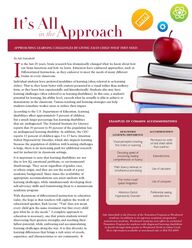
Return to flip book view
In the last 20 years, brain research has dramatically changed what we know about how our brain functions and how we learn. Educators have embraced approaches, such as Differentiated Instruction, as they endeavor to meet the needs of many different brains in every classroom.Individual students have preferred modalities of learning (often referred to as learning styles). That is, they learn better with content presented in a visual rather than auditory form, or they learn best experientially and kinesthetically. Students also may have learning challenges (often referred to as learning disabilities). In this case, a student’s potential for learning, his ability level, exceeds what he actually is able to achieve or demonstrate in the classroom. Various teaching and learning strategies can help students remediate weaker areas or reduce their impact.According to the U.S. Department of Education, learning disabilities affect approximately 5 percent of children, but a much larger percentage has learning disabilities that are undiagnosed. The National Institute for Literacy reports that 30 percent to 50 percent of the population has an undiagnosed learning disability. In addition, the CDC reports 11 percent of children ages 3 to 17 have Attention Deficit Hyperactivity Disorder, which also impacts learning. Because the population of children with learning challenges is large, there is an increasing push for additional research and for inclusivity in classroom settings.It is important to note that learning disabilities are not due to low IQ, emotional problems, or environmental disadvantage. They occur regardless of gender, race, or ethnic origin, and they are not the result of a poor academic background. Many times the availability of appropriate accommodations can assist students with learning challenges, while simultaneously developing their self-advocacy skills and transitioning them to a mainstream academic program. With discussions of differentiated instruction in education today, the hope is that teachers will explore the words of educational speaker, Rick Lavoie: “‘Fair’ does not mean every child gets the same treatment but that every child gets what he or she needs.” A complete approach to education is necessary, one that points students toward discovering their greatest strengths and reaching their fullest potential, while embracing and accommodating learning challenges along the way. It is this diversity in learning differences that brings a rich array of creeds, capacities, and characteristics to our community. By Jule SatterfieldIt’s All Approachin theAPPROACHING LEARNING CHALLENGES BY GIVING EACH CHILD WHAT THEY NEED.ExamplEs of Common aCCommodationsDIAGNOSED LEARNING DIFFERENCEACCOMMODATIONVisual perception, tracking, ne motor, or scanningPermission to write on test sheet rather than scantronDecoding, speed of processing, reading comprehension or uencyExtended timeMath uency, retrieval, or simultaneous processingUse of calculatorFine motor, visual/spatial integrationUse of computerAttention Decit Hyperactivity DisorderPreferential seating, extended timeJule Satterfield is the Director of the Transition Program at Woodward Academy. In addition to its rigorous academic program for mainstream students, Woodward Academy now offers its acclaimed Transition Program for students with diagnosed learning disabilities in fourth through sixth grades at Woodward North in Johns Creek. More information available at woodward.edu or 404-765-4090.